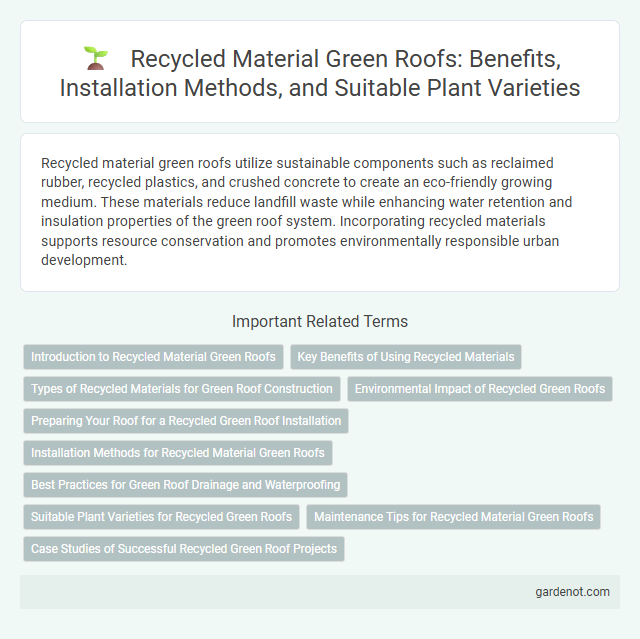Recycled material green roofs utilize sustainable components such as reclaimed rubber, recycled plastics, and crushed concrete to create an eco-friendly growing medium. These materials reduce landfill waste while enhancing water retention and insulation properties of the green roof system. Incorporating recycled materials supports resource conservation and promotes environmentally responsible urban development.
Introduction to Recycled Material Green Roofs
Recycled material green roofs utilize reclaimed or repurposed materials such as crushed concrete, recycled plastic, and reclaimed wood to create sustainable growing media and structural layers. These roofs reduce landfill waste and lower the environmental impact of green roof construction by minimizing the demand for virgin resources. Incorporating recycled materials enhances the overall eco-friendliness and durability of green roofing systems while promoting circular economy principles in urban landscaping.
Key Benefits of Using Recycled Materials
Recycled materials in green roof construction significantly reduce landfill waste and lower the demand for virgin resources, promoting environmental sustainability. These materials improve insulation and drainage properties, enhancing energy efficiency and prolonging the roof's lifespan. Utilizing recycled components also often reduces costs while supporting circular economy practices in urban development.
Types of Recycled Materials for Green Roof Construction
Recycled materials commonly used in green roof construction include crushed concrete, reclaimed bricks, and recycled plastics for drainage layers, which enhance sustainability and reduce landfill waste. Organic recycled media such as composted green waste and shredded wood improve substrate quality, promoting plant growth and water retention. Utilizing recycled rubber and glass also contributes to lightweight structural support, optimizing green roof longevity and environmental impact.
Environmental Impact of Recycled Green Roofs
Recycled material green roofs significantly reduce landfill waste by repurposing construction and industrial byproducts, such as crushed concrete, glass, and rubber, into sustainable roofing substrates. These roofs lower urban heat island effects by enhancing insulation and evapotranspiration while reducing carbon footprints associated with raw material extraction and processing. Implementing recycled green roofs supports circular economy principles, promotes biodiversity, and mitigates stormwater runoff, contributing to improved urban environmental health.
Preparing Your Roof for a Recycled Green Roof Installation
Preparing your roof for a recycled green roof installation involves inspecting structural integrity to support added weight from soil and vegetation. Ensure waterproofing membranes are intact and compatible with recycled materials, minimizing potential leaks or damage. Proper drainage systems must be installed to handle rainfall efficiently while maintaining sustainability through the use of recycled substrates and components.
Installation Methods for Recycled Material Green Roofs
Installation methods for recycled material green roofs involve layering a durable waterproof membrane followed by a root barrier to protect the building structure. Lightweight recycled substrates, such as crushed concrete or recycled glass, are evenly distributed to ensure proper drainage and support plant growth. Modular trays made from recycled plastics can be used to facilitate quick installation and maintenance while enhancing sustainability.
Best Practices for Green Roof Drainage and Waterproofing
Using recycled materials like crushed concrete and reclaimed rubber in green roof drainage layers enhances sustainability while maintaining effective water flow. Best practices for waterproofing involve applying high-performance membranes such as EPDM or TPO, paired with root barriers to prevent membrane degradation and leaks. Proper installation includes layering drainage mats and ensuring positive slope design to optimize water runoff and protect building integrity.
Suitable Plant Varieties for Recycled Green Roofs
Sedum, native grasses, and drought-tolerant succulents thrive on recycled material green roofs due to their shallow root systems and low nutrient needs. These plant varieties enhance the sustainability of green roofs by efficiently utilizing reclaimed substrates while promoting biodiversity. Incorporating native wildflowers further supports pollinators and improves ecosystem health on recycled green roofing systems.
Maintenance Tips for Recycled Material Green Roofs
Regular inspection of recycled material green roofs ensures debris and plant overgrowth do not obstruct drainage systems, maintaining optimal water flow. Utilizing eco-friendly cleaning agents prevents damage to recycled substrates and supports sustainable roof longevity. Monitoring moisture levels and repairing any damage promptly extends the durability and performance of recycled green roofing materials.
Case Studies of Successful Recycled Green Roof Projects
Case studies of recycled material green roof projects demonstrate significant environmental and economic benefits, such as the Ford Rouge Center in Dearborn, Michigan, which utilized recycled rubber and plastic substrates to reduce landfill waste and improve insulation. The Vancouver Convention Centre Green Roof incorporates recycled construction waste as a growing medium, enhancing stormwater management and biodiversity while lowering urban heat island effects. These projects highlight the practical application of recycled materials that contribute to sustainable urban development and showcase scalable models for future green infrastructure.
Recycled material green roof Infographic

 gardenot.com
gardenot.com